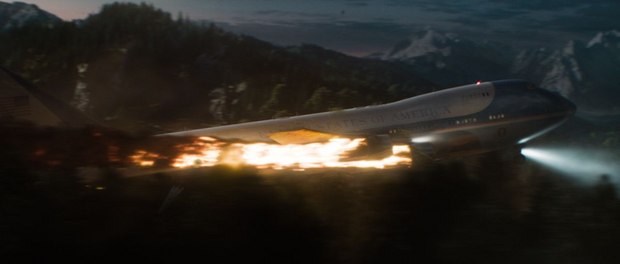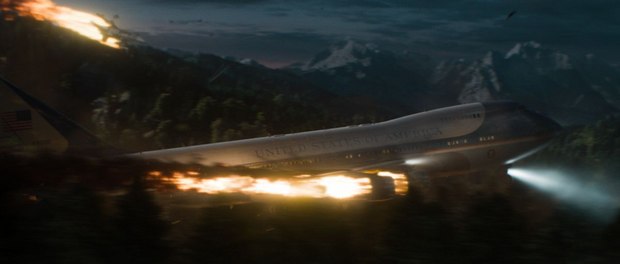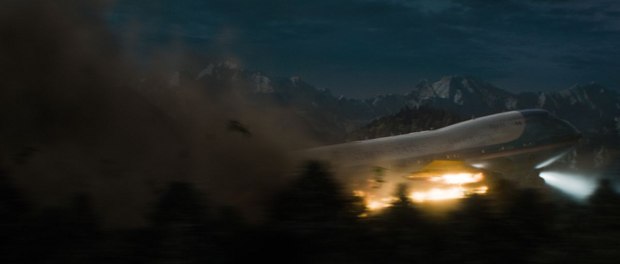The VFX studio tackles Finnish director Jalmari Helander’s action adventure tale of a young boy who rescues the U.S. president.
When Jalmari Helander decided to reteam with his Rare Exports: A Christmas Tale (2010) star and nephew Onni Tommila, he traded Santa Claus for another iconic figure. “There’s a pragmatic reason for that, which is to have something that everyone can recognize,” remarks Helander while attending the 39th Toronto International Film Festival to promote Big Game (2014). “It’s a good pitch to say to somebody that the President of the United States has crash landed with Air Force One in the forest and there is a young boy. It elevates the idea.” Helming a Hollywood blockbuster featuring Jim Broadbent (Iris) and Samuel L. Jackson (Unbreakable) was not daunting for the Finnish filmmaker. “We also had in Rare Exports huge locations but this time it was much bigger. In some cases Big Game was easier than Rare Exports. We had more time and a big crew to help us to accomplish what we wanted to do. It was great.”
“Most of the inspiration came from the 1980s and early 1990s, like E.T. or Indiana Jones,” says Helander, who admires the work of Steven Spielberg (Lincoln). “He is a big influence. When I was seven I saw E.T. for the first time, and that’s when I started to think movies like this were cool.” Developing the story was not easy for the director. “The most challenging part for me was writing the script. That took a long time to do it. It’s hard work.” Big Game, which follows the action adventure tradition of combining humour with crazy stunts, was shot mainly on location. “The mountains were great. We were shooting in them for most of the time. It was hard to get everyone to the place every morning but it was definitely worth it; the scenery was great and beautiful,” says Helander. Oddly enough the cinematic moment which caused him the most concern did not involve an intricate action sequence. As he explains, “I can’t remember how many pages it was but the campfire scene was a long conversation between Oscar [Onni Tommila] and the President [Samuel L. Jackson]. It turned out to be a cool scene. It was the last scene together for Onni and Sam, and there’s some magic in it.”
According to Helander, “I can’t say that there was a lot of green screen but there was some. There were some scenes that we couldn’t do for real.” Tasked with creating the visual effects was Scanline VFX. “The shoot took place at the Bavaria film studios, so the overall plan was to get as much work as possible done at one place to optimize the workflow and to have a more efficient production,” states Scanline senior VFX producer Jasmin Hasel. “Despite that, Jalmari was in love with our Air Force One shots for Roland Emmerich's White House Down [2013]. This helped us a lot to get the job because there were important shots with the Air Force One in Big Game as well.” A lot of digital matte paintings had to be created along with set extensions and destruction work requiring CG simulations. “Jalmari provided us with storyboards early on in the production,” remarks Scanline VFX supervisor Jan Krupp. “Also, we had some meetings before and during the shoot where Jalmari explained to us, sometimes with the help of scribbles and reference footage, what he wanted to see. During the post-production we had cineSync sessions whenever they were needed.”
“Our approach was to deliver techvis so that Jalmari and Mika Orasmaa [DOP] could have a sheet with all our camera setups as well as a visual reference how a shot could look like, and how they needed to setup their shootings,” explains Scanline associate VFX producer Markus Hagemeier. “We did not previs all of the shots but mainly the Ejection Seat Sequence; this sequence was planned to be shot with the two actors on a real ejection seat prop in front of the green screen, and a mixture of helicopter plates and digital matte paintings for the background. Since there was a tight shooting schedule, not all of the plates could be shot as planned in the previz. For some of the shots we did a postviz or had remote sessions with Jalmari where he could interactively watch the artist's desktop from the editorial in Finland. As the artist laid out the shot, Jalmari could directly give him instructions as to how the camera movement and framing should be.”
Air Force One gets destroyed while flying over Finland. “Part of the briefing from Jalmari for these shots was that the explosion must be big enough to empty the mountain lake,” reveals Krupp. “We were looking at a lot of footage that would feature massive explosions. The references that were best matching to what Jalmari wanted were an underwater atomic explosion combined with gas and fuel explosion that would have big fireballs with thick black smoke. Those shots were the ‘hero shots’ of the show and they were worked on over the whole course of the show.”
Krupp continues, “Most challenging here was that there were multiple simulations for different elements that were affecting each other and all had to be brought into sync with the timing and progression of the explosion that was shown in three shots through different cameras angles.” The under siege U.S. leader survives the destruction of the presidential aircraft. As Krupp explains, “For the sequence where the escape pod is dropped from Air Force One and the agents jump out of the plane, there would not be any aerial footage, so we had to build a digital environment with a thick cloud layer and for some shots we would dive with one agent through the clouds just before some surface-to-air missiles pass the camera. We decided to go for a mixture of digital matte paintings and simulated clouds which we did with Flowline for those shots where the camera actually dives through the clouds. For the shots where the Air Force One is flying very low with engines on fire over the forest and brushes the treetops, we decided to go for a full CG environment.”
Handling a submerged Air Force One was straightforward. “We had storyboards right from the start, and the final shots are pretty much like they were boarded,” states Krupp. “We started with a concept to determine the amount of destruction that would be visible on Air Force One, and how murky the water and the light situation would be. A plate of the actors diving in front of an underwater green screen was shot, renderings of a destroyed 3D model of the Air Force One, digital matte paintings for destruction details and the lake environment as well renderings and footage for the underwater atmospherics were used in the final composite.” Digital versions of the cast make an appearance. According to Krupp, “Our set of digital doubles included Oskari [Onni Tommila], the President and Morris [Ray Stevenson] as well as a Secret Service agent who we used on some wider shots in the Escape Pod and Ejection Seat Battle. Also in the Escape Pod Sequence, the environment outside Air Force One above and below the clouds is full CG. The forest in all of the shots where the burning Air Force One can be seen flying on fire were done with CG trees and digital matte paintings for the further background.”
“There was one shot in the Ejection Seat Sequence on which our previs didn't match the plate that was shot,” remarks Markus Hagemeier. “But to get the same dynamic and speed we had in our layout, we had to track the plate first, then we needed to retime it in compositing, give it back to the animators to tweak in additional camera moves and then we could start working on all the CG-simulation and matte paintings, and the final compositing.” Krupp adds, “The biggest challenge was the Air Force One explosion shots in the Ejection Seat Sequence, partially because there are not many real world examples as to how this could look and due to the amount of complex simulation work that was required. There were three key points that were crucial for getting this done. We had to find references that could give an idea about the possible elements of that explosion. The concepts would show how those explosion elements could look in our shots and what method could be chosen to achieve this look. We needed fast iterations with simplified simulations to lockdown the timing of the explosion and determine certain visual key events that would happen during those three shots and would influence the size and shape of the explosion.”
Other VFX facilities were involved with action adventure. “The bigger part of the VFX work was done at Scanline VFX,” Hagemeier notes. “But we were working with another German vendor to outsource some parts of the work. Also, there were some retouches we didn't finalize in Munich.” Cinematically all of the hard effort paid off. “Every time we watched the Ejection Seat Sequence we had a lot of fun. The more progress we made, the more fun it was. We also thought that the Escape Pod Sequence looked nice, not only our visual effects work but also the final colour grading and sound; everything worked together in the end.” Big Game was an enjoyable project as well for Krupp. “Working with Jalmari was a great experience and really fun. Jalmari was demanding and had a clear vision of what he wanted to achieve with the visual effects. On the other hand Jalmari was extremely aware of the budget and always keen to find solutions with us to get the most out of it; hopefully I will get the chance to work again with him.”
Helander, who is is developing his next project, explains, “I have a few ideas and what I am currently thinking is that Onni would be in it. I was going to go smaller next time but I don’t think that way anymore. I want to do a hell of a lot bigger now.”
--
Trevor Hogg is a freelance video editor and writer best known for composing in-depth filmmaker and movie profiles for sites such as the CGSociety, 3DTotal, Live for Films and Flickering Myth.


























